Biophysical Properties of Foamed and Solid Polymers Used in Orthotics and Prosthetics
Abstract
:1. Introduction
2. Materials and Methods
2.1. Materials
2.1.1. Substrate
2.1.2. Bacteria
2.2. Methods
2.2.1. Surface Morphology and Roughness
2.2.2. Zeta Potential Measurements
2.2.3. Contact Angle Measurements
2.2.4. Mechanical Properties: Tensile and Hardness Tests
2.2.5. Monitoring of Bacterial Adhesion on Surfaces
2.2.6. Color Measurements of Orthotic Materials
3. Results
3.1. Surface Morphology/Topography and Roughness
3.2. Zeta Potential
3.3. Contact Angle Measurements
3.4. Mechanical Properties
3.5. Bacterial Adhesion Extent
3.6. Color Parameters
4. Discussion
4.1. Surface Morphology/Topography and Roughness
4.2. Zeta Potential
4.3. Contact Angle Measurements
4.4. Mechanical Properties
4.5. Bacterial Adhesion Extent
4.6. Color Parameters
5. Conclusions
Supplementary Materials
Author Contributions
Funding
Institutional Review Board Statement
Informed Consent Statement
Data Availability Statement
Acknowledgments
Conflicts of Interest
References
- Muñoz-Pascual, S.; Saiz-Arroyo, C.; Vuluga, Z.; Corobea, M.C.; Rodriguez-Perez, M.A. Foams with Enhanced Ductility and Impact Behavior Based on Polypropylene Composites. Polymers 2020, 12, 943. [Google Scholar] [CrossRef] [Green Version]
- Labour, T.; Bauthier, C.; Seguela, R.; Vigier, G.; Bomal, Y.; Orange, G. Influence of the β crystalline phase on the mechanical properties of unfilled and CaCO3-filled polypropylene. I. Structural and mechanical characterization. Polymer 2001, 42, 7127. [Google Scholar] [CrossRef]
- Karger-Kocsis, J. Polypropylene: Structure, Blends and Composites; Chapman & Hall: London, UK, 1995; Volume 3. [Google Scholar]
- Kennedy, M.A.; Peacock, A.J.; Mandelkern, L. Tensile Properties of Crystalline Polymers: Linear Polyethylene. Macromolecules 1994, 27, 5297–5310. [Google Scholar] [CrossRef]
- Amjadi, M.; Fatemi, A. Tensile Behavior of High-Density Polyethylene Including the Effects of Processing Technique, Thickness, Temperature, and Strain Rate. Polymers 2020, 12, 1857. [Google Scholar] [CrossRef]
- Llewelyn, G.; Rees, A.; Griffiths, C.; Jacobi, M. A Design of Experiment Approach for Surface Roughness Comparisons of Foam Injection-Moulding Methods. Materials 2020, 13, 2358. [Google Scholar] [CrossRef] [PubMed]
- Zhang, Y.; Rodrigue, D.; Ait-Kadi, A. High Density Polyethylene Foams. III. Tensile Properties. J. Appl. Polym. Sci. 2003, 90, 2130–2138. [Google Scholar] [CrossRef]
- Gibson, L.J.; Ashby, M.F. Cellular Solids: Structure and Properties, 2nd ed.; Camridge University Press: Cambridge, UK, 1997. [Google Scholar]
- Mehta, B.S.; Colombo, E.A. Mechanical properties of Foamed Thermplastics. J. Cell. Plast. 1976, 12, 59. [Google Scholar] [CrossRef]
- Iizuka, M.; Goto, R.; Siegkas, P.; Simpson, B.; Mansfield, N. Large Deformation Finite Element Analyses for 3D X-ray CT Scanned Microscopic Structures of Polyurethane Foams. Materials 2021, 14, 949. [Google Scholar] [CrossRef] [PubMed]
- Klempner, D.; Frisch, K.C. Handbook of Polymeric Foams and Foam Technology; Hanser: Munich, Germany, 1991. [Google Scholar]
- Rumianek, P.; Dobosz, T.; Nowak, R.; Dziewit, P.; Aromiński, A. Static Mechanical Properties of Expanded Polypropylene Crushable Foam. Materials 2021, 14, 249. [Google Scholar] [CrossRef]
- Kogler, G.F. Materials and technology. In Orthotics and Prosthetics in Rehabilitation, 3rd ed.; Lusardi, M., Jorge, M., Nielsen, C., Eds.; St. Louis: Saunders, MO, USA, 2012; pp. 143–160. [Google Scholar]
- Grice, E.A.; Serge, J.A. The skin microbiome. Nat. Rev. Microbiol. 2011, 9, 244–253. [Google Scholar] [CrossRef]
- Coates, R.; Moran, J.; Horsburg, M.J. Staphylococci: Colonisers and pathogens of human skin. Future Microbiol. 2014, 9, 75–91. [Google Scholar] [CrossRef] [PubMed]
- Dalton, H.M.; March, P.E. Molecular genetics of bacterial attachment and biofouling. Curr. Opin. Biotechnol. 1998, 9, 252–255. [Google Scholar] [CrossRef]
- An, Y.H.; Friedman, R.J. Concise review of mechanisms of bacterial adhesion to biomaterial surfaces. J. Biomed. Mater. Res. 1997, 43, 338–348. [Google Scholar] [CrossRef]
- Isaacson, R.E. Pilus Adhesins. In Bacterial Adhesion: Mechanisms and Physiological Significance; Savage, D.C., Madilyn, F., Eds.; Plenum Press: Coventry, UK, 1985; pp. 307–336. [Google Scholar]
- Fletcher, M.; Floodgate, G.D. An electron-microscopic demonstration of as acidic polysaccharide involved in the adhesion of a marine bacterium to solid surfaces. J. Gen. Microbiol. 1973, 74, 325–334. [Google Scholar] [CrossRef] [Green Version]
- McKee, P.R.; Rivard, A. Biopsychosocial approach to orthotic intervention. J. Hand Ther. 2011, 24, 155–163. [Google Scholar] [CrossRef] [PubMed]
- Ozkocak, I.; Hekim, M.; Gokturk, H.; Adem, K.; Comert, O. The assessment of different bleaching agents’ efficiency on discoloured teeth using image-processing methods. Photodiagnosis Photodyn. Ther. 2020, 31, 101901. [Google Scholar] [CrossRef] [PubMed]
- Ly, B.C.K.; Dyer, E.B.; Feig, J.L.; Chien, A.L.; Del Bino, S. Research techniques made simple: Cutaneous colorimetry: A reliable technique for objective skin color measurement. J. Invest. Dermatl. 2020, 140, 3–12.e1. [Google Scholar] [CrossRef] [Green Version]
- Zore, A.; Bezek, K.; Jevšnik, M.; Abram, A.; Runko, V.; Sliškovič, I.; Raspor, P.; Kovačević, D.; Bohinc, K. Bacterial adhesion rate on food grade ceramics and Teflon as kitchen worktop surfaces. Int. J. Food Microbiol. 2020, 332, 108764. [Google Scholar] [CrossRef]
- Gorjan, M.; Virant, P.; Rojko, F.; Abramn, A.; Rudolf, R.; Raspor, P.; Zore, A.; Bohinc, K. Bacterial adhesion of Streptococcus mutans to dental material surfaces. Molecules 2021, 26, 1–15. [Google Scholar]
- Katsikogianni, M.; Missirlis, Y. Concise review of mechanisms of bacterial adhesion to biomaterials and of techniques used in estimating bacteria-material interactions. Eur. Cell. Mater. 2004, 8, 37–57. [Google Scholar] [CrossRef]
- Bohinc, K.; Dražić, G.; Fink, R.; Oder, M.; Jevšnik, M.; Nipič, D.; Godič Torkar, K.; Raspor, P. Available surface dictates microbial adhesion capacity. Int. J. Adhes. Adhes. 2014, 50, 265–272. [Google Scholar] [CrossRef]
- Bohinc, K.; Dražić, G.; Abram, A.; Jevšnik, M.; Jeršek, B.; Nipič, D.; Kurinčič, M.; Raspor, P. Metal surface characteristics dictate bacterial adhesion capacity. Int. J. Adhes. Adhes. 2016, 68, 39–46. [Google Scholar] [CrossRef]
- Janovak, L.; Deak, A.; Tallosy, S.P.; Sebok, D.; Csapo, E.; Bohinc, K.; Abram, A.; Palinko, A.; Dekany, I. Hydroxyapatite-enhanced structural, photocatalytic and antibacterial properties of photoreactive TiO[sub]2/HAp/polyacrylate hybrid thin films. Surf. Coat. Technol. 2017, 326, 316–326. [Google Scholar] [CrossRef]
- Poortinga, A.T.; van den Bos, R.; Norde, W.; Busscher, H.J. Electrical double layer interactions in bacterial adhesion to surfaces. Surf. Sci. Rep. 2002, 47, 1–32. [Google Scholar] [CrossRef]
- Boks, N.P.; Norde, W.; Van Der Mei, H.C.; Busscher, H.J. Forces involved in bacterial adhesion to hydrophilic and hydrophobic surfaces. Microbiology 2008, 154, 3122–3133. [Google Scholar] [CrossRef] [Green Version]
- Rimondini, L.; Fini, M.; Giardino, R. The microbial infection of biomaterials: A challenge for clinicians and researchers. A short review. J. Appl. Biomater. Biomech. 2004, 3, 1–10. [Google Scholar]
- Goncalves, F.; Correia, P.; Silva, S.P.; Almeida-Aguiar, C. Evaluation of antimicrobial properties of cork. FEMS Bact. Adhes. Femtosecond Laser-Modif. Polyethyl. Microbiol. Lett. 2016, 363, fnv231. [Google Scholar] [CrossRef] [PubMed] [Green Version]
- Schwibbert, K.; menzel, F.; Epperlein, N.; Bonse, J.; Kruger, J. Bacterial Adhesion on Femtosecond Laser-Modified Polyethylene. Materials 2019, 12, 3107. [Google Scholar] [CrossRef] [PubMed] [Green Version]
- Oliveira, W.F.; Silva, P.M.S.; Silva, R.C.S.; Silva, G.M.M.; Machado, G.; Coelho, L.C.B.B.; Correia, M.T.S. Staphylococcus aureus and Staphylococcus epidermidis infections on implants. J. Hosp. Infect. 2018, 98, 111–117. [Google Scholar] [CrossRef]
- Gartner, U.; Gošnak Dahmane, R.; Slaheddine, G.; Zore, A.; Bohinc, K. Bacterial adhesion on orthopedic implants. Adv. Colloid Interface Sci. 2020, 283, 1–12. [Google Scholar]
- Del Bino, S.; Bernerd, F.J.B.J.o.D. Variations in skin colour and the biological consequences of ultraviolet radiation exposure. Br. J. Derm. 2013, 169, 33–40. [Google Scholar] [CrossRef] [PubMed] [Green Version]
- DeGeyter, N.; Morent, R.; Leys, C. Surface characterization of plasma-modified polyethylene by contact angle experiments and ATR-FTIR spectroscopy. Surf. Interface Anal. 2008, 40, 608–611. [Google Scholar] [CrossRef]
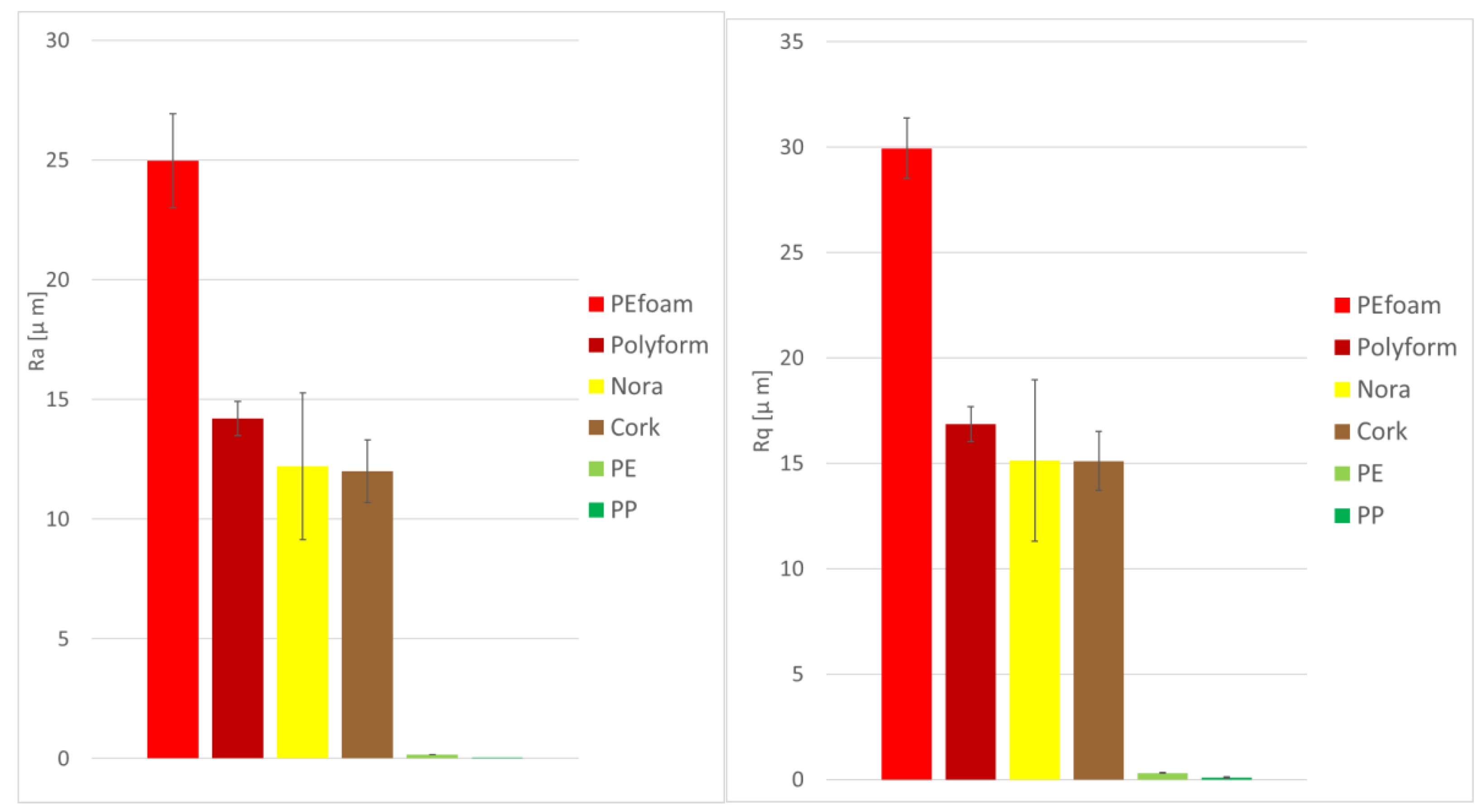

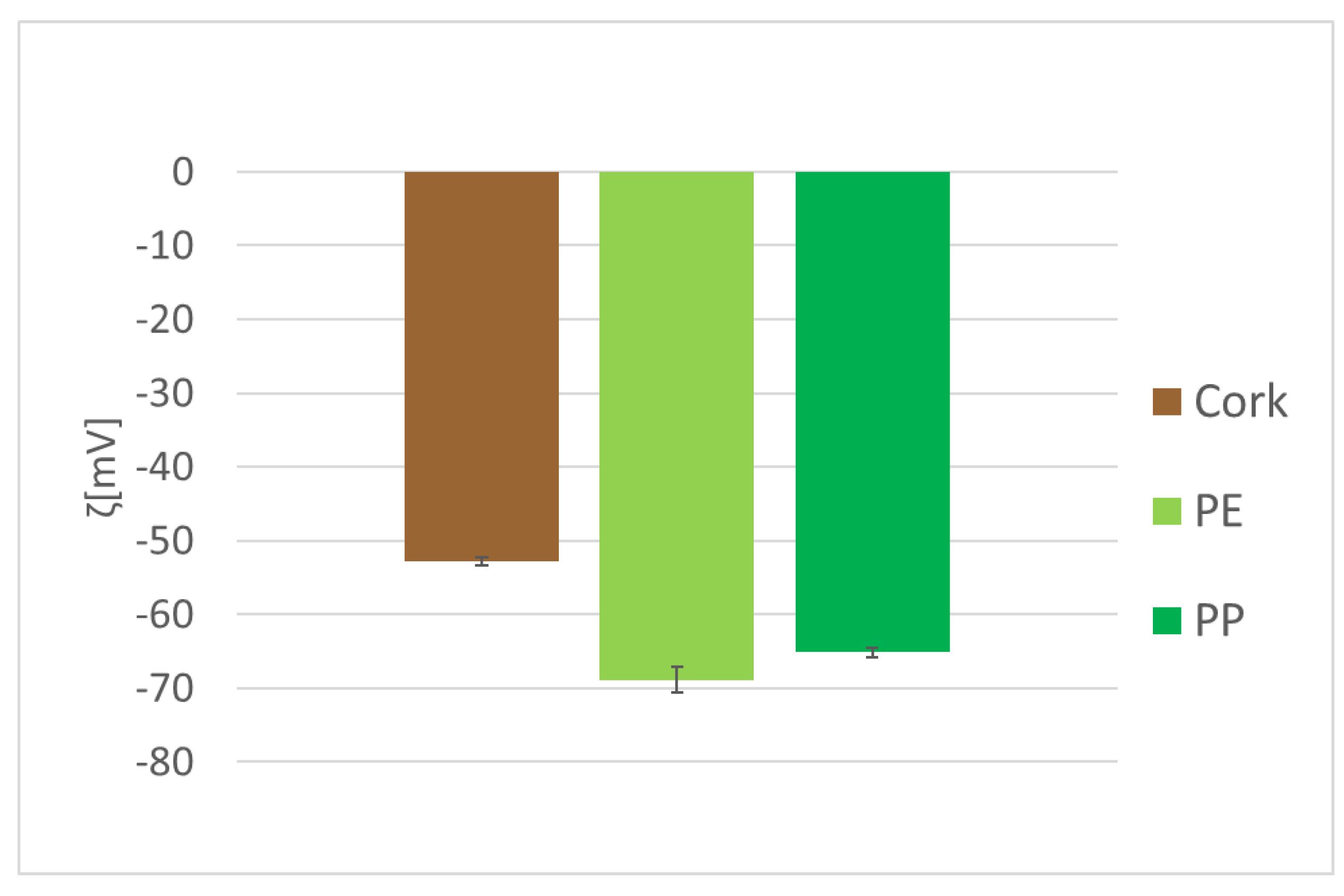

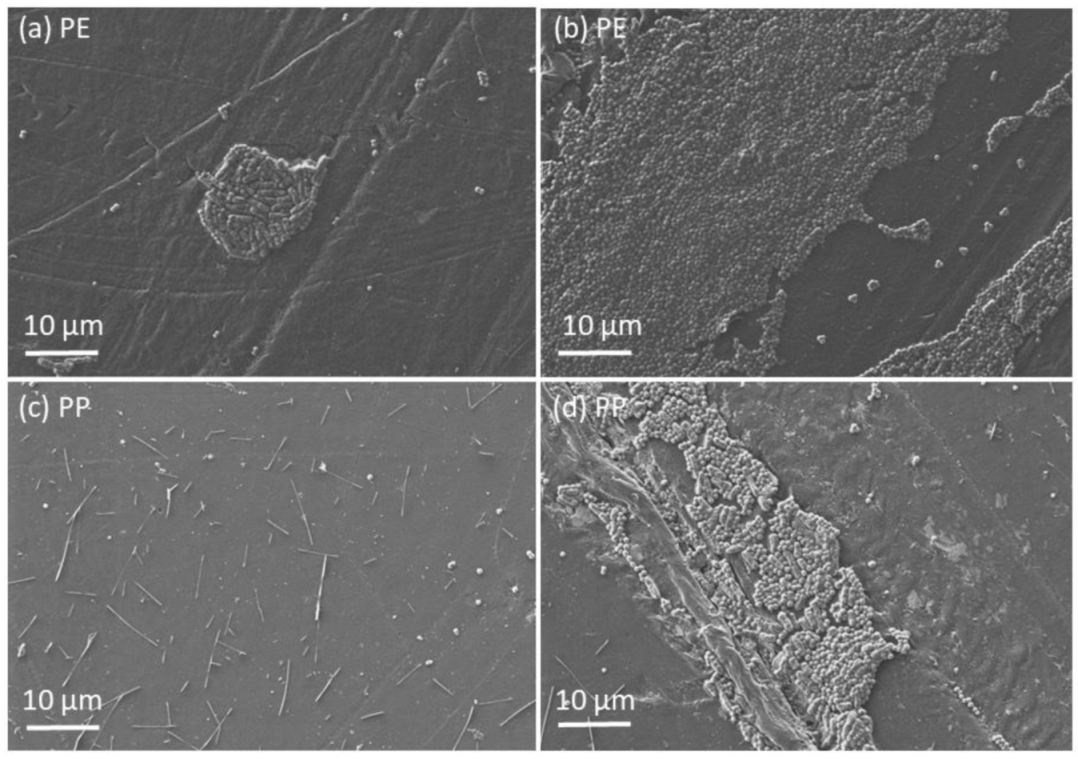
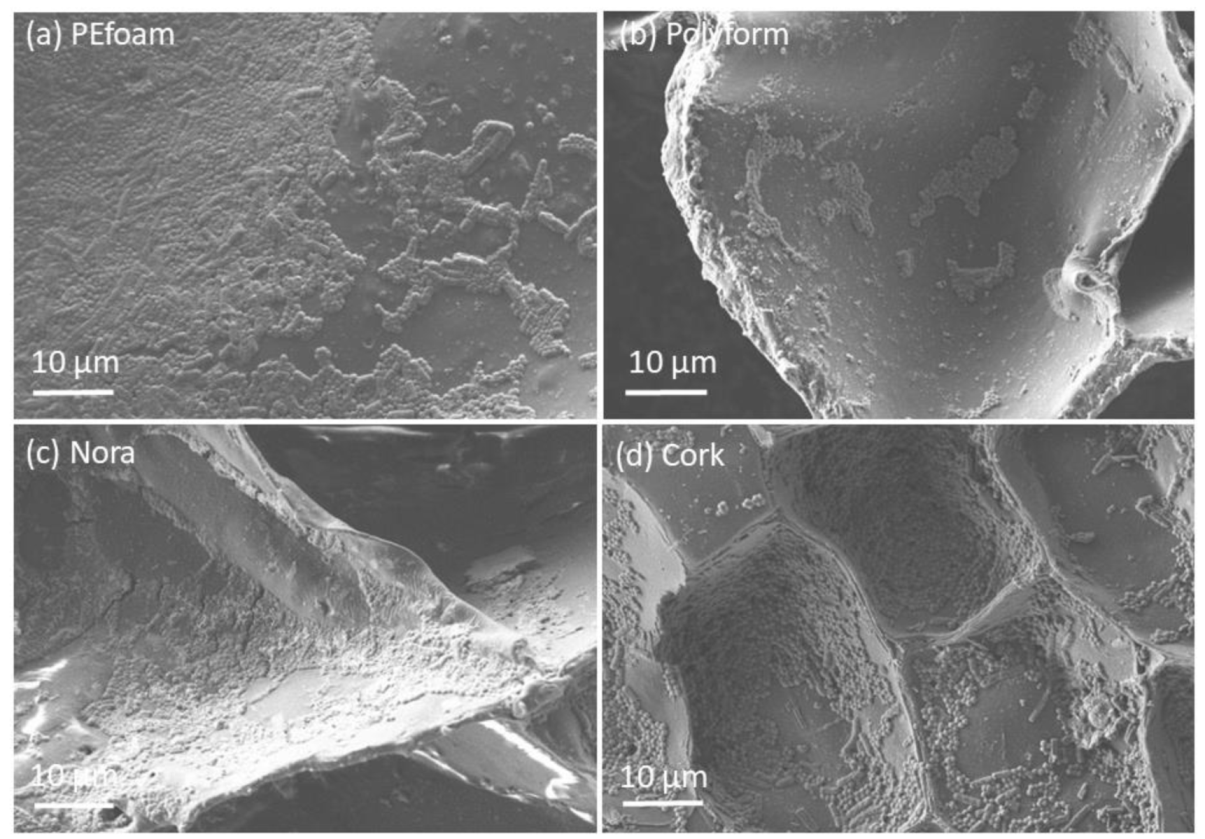
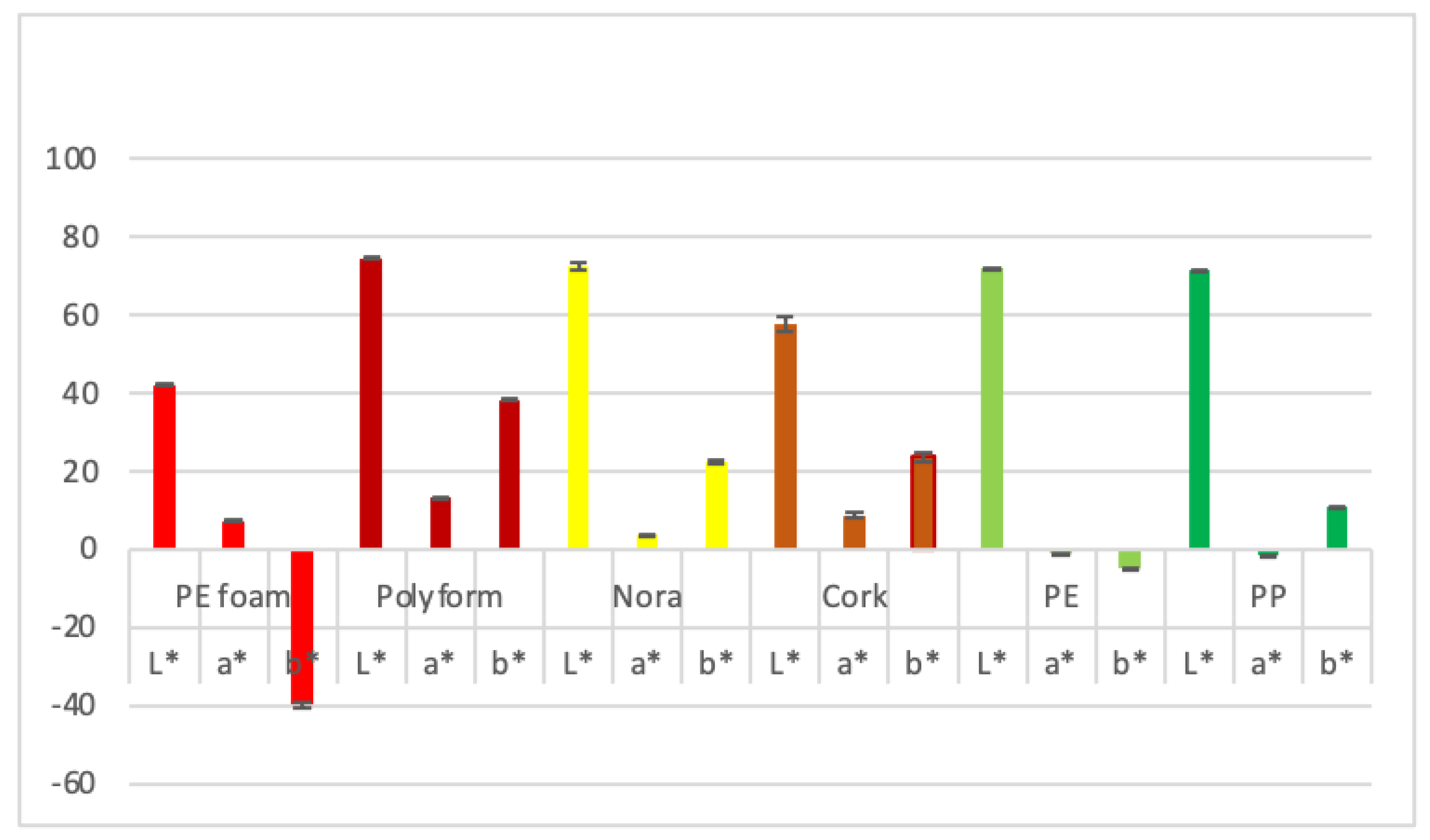
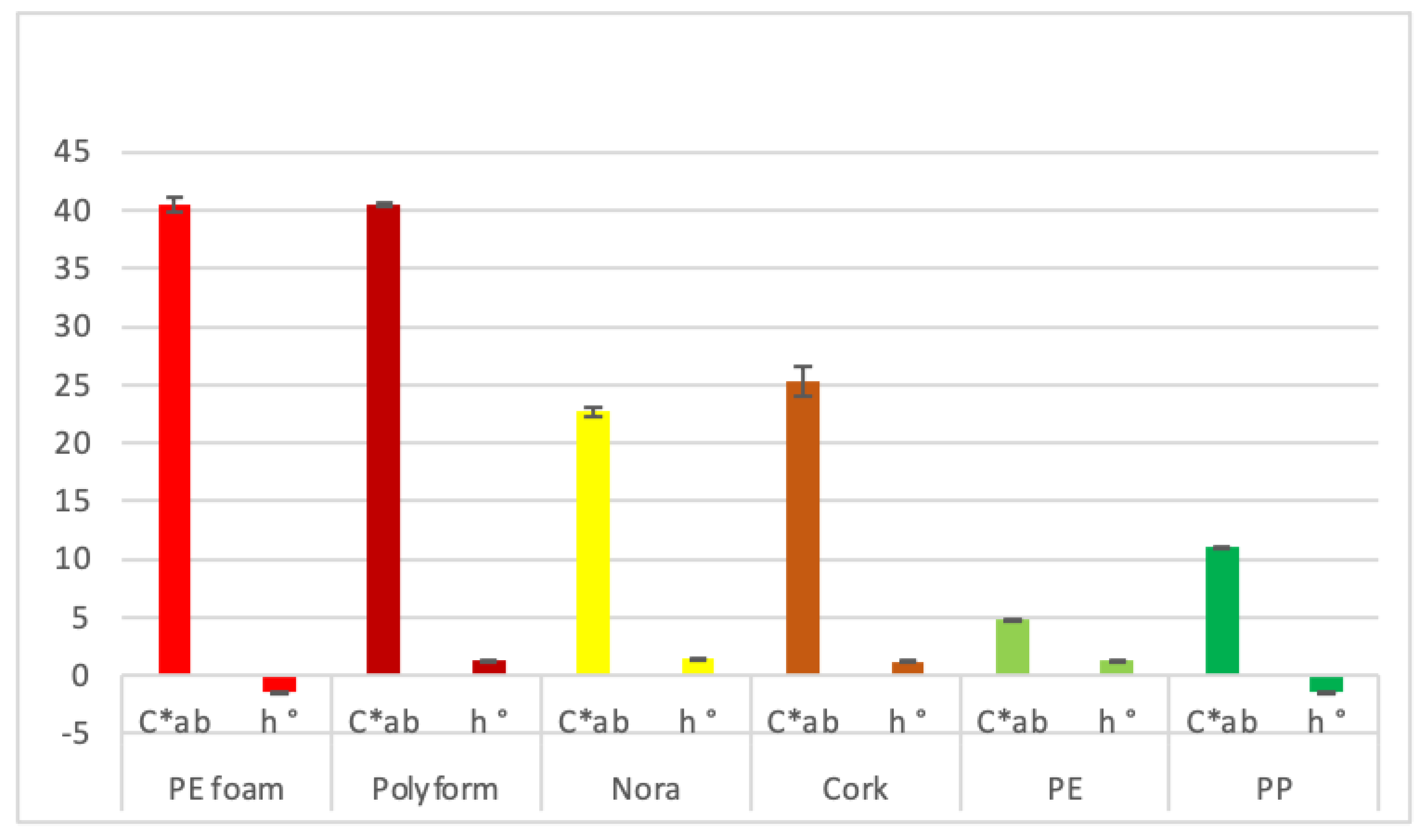
| Designation | Material | Type | Product Name | Density (g/cm3) |
|---|---|---|---|---|
| PEfoam | Polyethylene | foamed | no data | 0.125 |
| Polyform | Polyethylene | foamed | Polyform | 0.149 |
| Nora | Poly(ethylene-vinyl acetate) | foamed | Nora | 0.075 |
| Cork | Cork-natural polymeric composite material | foamed | Cork | 0.103 |
| PE | Polyethylene | solid | Polyethylene | 0.945 |
| PP | Polypropylene | solid | Polypropylene | 0.916 |
| Material | Surface Free Energy/mJm−2 |
|---|---|
| PEfoam | 16.8 |
| Polyform | 22.4 |
| Nora | 30.8 |
| Cork | 22.4 |
| PE | 33.8 |
| PP | 30.5 |
| E (MPa) | σY (MPa) | εY (%) | σM (MPa) | ε M (%) | ε B (%) | Hardness (Shore A) | |
|---|---|---|---|---|---|---|---|
| PEfoam | 10.5 ± 1.3 | 1.16 ± 0.02 | 86.0 ± 7 | 87.8 ± 6.7 | 32.4 ± 0.5 | ||
| Polyform | 5.38 ± 0.35 | 2.03 ± 0.04 | 156 ± 3 | 157 ± 3.2 | 28.9 ± 0.2 | ||
| Nora | 1.54 ± 0.06 | 1.27 ± 0.10 | 96.0 ± 6 | - | 15.0 ± 0 | ||
| Cork | 43.8 ± 11.8 | 0.898 ± 0.249 | 3.00 ± 1 | - | 63.6 ± 0.9 | ||
| PE | 1380 ± 24 | 21.0 | 10.0 | 28.3 ± 0.9 | 470 ± 10 | 471.7 ± 9.8 | 93.4 ± 0.5 |
| PP | 2250 ± 18 | 33.0 ± 0.3 | 4.00 ± 0 | 33.0 ± 0.3 | 4.00 ± 0 | 59.0 ± 26 | 93.2 ± 0.4 |
| C*ab | h° | |
|---|---|---|
| Very light | 14.96 | 1.32 |
| Light | 18.76 | 1.19 |
| Intermediate | 20.11 | 1.19 |
| Tan | 22.58 | 1.11 |
| Brown | 22.58 | 1.11 |
| Dark | 14.56 | 0.92 |
Publisher’s Note: MDPI stays neutral with regard to jurisdictional claims in published maps and institutional affiliations. |
© 2021 by the authors. Licensee MDPI, Basel, Switzerland. This article is an open access article distributed under the terms and conditions of the Creative Commons Attribution (CC BY) license (https://creativecommons.org/licenses/by/4.0/).
Share and Cite
Bohinc, K.; Abram, A.; Zore, A.; Štukelj, R.; Lenarčič, A.; Vidrih, R.; Škapin, A.S. Biophysical Properties of Foamed and Solid Polymers Used in Orthotics and Prosthetics. Materials 2021, 14, 6877. https://doi.org/10.3390/ma14226877
Bohinc K, Abram A, Zore A, Štukelj R, Lenarčič A, Vidrih R, Škapin AS. Biophysical Properties of Foamed and Solid Polymers Used in Orthotics and Prosthetics. Materials. 2021; 14(22):6877. https://doi.org/10.3390/ma14226877
Chicago/Turabian StyleBohinc, Klemen, Anže Abram, Anamarija Zore, Roman Štukelj, Ana Lenarčič, Rajko Vidrih, and Andrijana Sever Škapin. 2021. "Biophysical Properties of Foamed and Solid Polymers Used in Orthotics and Prosthetics" Materials 14, no. 22: 6877. https://doi.org/10.3390/ma14226877
APA StyleBohinc, K., Abram, A., Zore, A., Štukelj, R., Lenarčič, A., Vidrih, R., & Škapin, A. S. (2021). Biophysical Properties of Foamed and Solid Polymers Used in Orthotics and Prosthetics. Materials, 14(22), 6877. https://doi.org/10.3390/ma14226877








